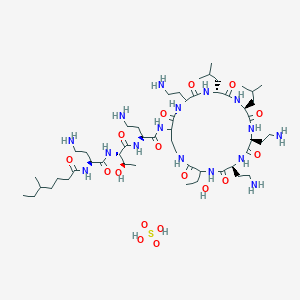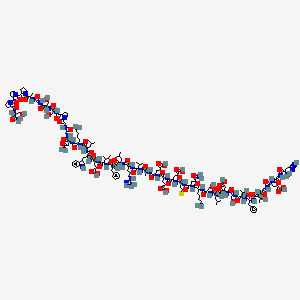
Byetta
描述
艾克赛汀-4是一种由39个氨基酸组成的肽,是胰高血糖素样肽-1(GLP-1)的类似物。它最初是从希拉巨蜥(Heloderma suspectum)的毒液中分离出来的。 艾克赛汀-4因其胰岛素促分泌特性而备受关注,使其成为治疗2型糖尿病的宝贵化合物 .
准备方法
合成路线和反应条件: 艾克赛汀-4可以使用重组DNA技术合成。一种常见的方法是在毕赤酵母(Pichia pastoris)中表达该肽。编码艾克赛汀-4的基因被插入酵母中,酵母随后会产生该肽。 随后使用色谱技术纯化该肽 .
工业生产方法: 为了大规模生产,艾克赛汀-4通常使用大肠杆菌或毕赤酵母系统生产。该过程包括发酵这些微生物,然后进行纯化步骤以分离肽。 这种方法经济高效,适合大规模生产 .
化学反应分析
反应类型: 艾克赛汀-4会经历各种化学反应,包括:
氧化: 该反应可能发生在肽中的蛋氨酸残基处。
还原: 肽中的二硫键可以还原为硫醇基。
常用试剂和条件:
氧化: 过氧化氢或其他氧化剂。
还原: 二硫苏糖醇(DTT)或其他还原剂。
取代: 定点诱变技术用于取代特定的氨基酸.
主要产物: 从这些反应中形成的主要产物包括艾克赛汀-4的氧化、还原和取代类似物,它们各自具有独特的性质和潜在的治疗应用 .
科学研究应用
艾克赛汀-4在科学研究中具有广泛的应用,包括:
化学: 用作研究蛋白质折叠和稳定性的模型肽.
生物学: 研究其在调节葡萄糖代谢和胰岛素分泌中的作用.
医学: 临床上用于治疗2型糖尿病,通过增强胰岛素分泌和降低血糖水平来治疗.
工业: 用于开发治疗代谢紊乱的新治疗剂.
作用机制
艾克赛汀-4通过与胰高血糖素样肽-1受体(GLP-1R)结合来发挥作用。这种结合激活腺苷酸环化酶,导致环磷酸腺苷(cAMP)水平升高。升高的cAMP激活蛋白激酶A(PKA),进而磷酸化参与葡萄糖代谢的各种靶蛋白。 这一系列事件导致胰岛素分泌增强、胰高血糖素分泌减少以及葡萄糖稳态改善 .
类似化合物:
胰高血糖素样肽-1 (GLP-1): 与艾克赛汀-4具有结构和功能相似性,但半衰期更短。
艾塞那肽: 艾克赛汀-4的合成形式,临床上用于治疗2型糖尿病.
独特性: 艾克赛汀-4的独特之处在于其半衰期比GLP-1更长,使其在治疗应用中更有效。 此外,它源于希拉巨蜥的毒液,为其发现和发展增添了迷人的方面 .
相似化合物的比较
Glucagon-like peptide-1 (GLP-1): Shares structural and functional similarities with Exendin-4 but has a shorter half-life.
Exenatide: A synthetic form of Exendin-4 used clinically to treat type 2 diabetes.
Uniqueness: Exendin-4 is unique due to its longer half-life compared to GLP-1, making it more effective for therapeutic use. Additionally, its origin from the Gila monster’s venom adds a fascinating aspect to its discovery and development .
属性
IUPAC Name |
5-[[2-[[1-[[1-[[1-[[1-[[1-[[1-[[1-[[6-amino-1-[[5-amino-1-[[1-[[1-[[1-[[1-[[1-[[1-[[1-[[1-[[1-[[1-[[1-[[1-[[1-[[6-amino-1-[[4-amino-1-[[2-[[2-[2-[[1-[[1-[[2-[[1-[2-[2-[2-[(1-amino-3-hydroxy-1-oxopropan-2-yl)carbamoyl]pyrrolidine-1-carbonyl]pyrrolidine-1-carbonyl]pyrrolidin-1-yl]-1-oxopropan-2-yl]amino]-2-oxoethyl]amino]-3-hydroxy-1-oxopropan-2-yl]amino]-3-hydroxy-1-oxopropan-2-yl]carbamoyl]pyrrolidin-1-yl]-2-oxoethyl]amino]-2-oxoethyl]amino]-1,4-dioxobutan-2-yl]amino]-1-oxohexan-2-yl]amino]-4-methyl-1-oxopentan-2-yl]amino]-3-(1H-indol-3-yl)-1-oxopropan-2-yl]amino]-4-carboxy-1-oxobutan-2-yl]amino]-3-methyl-1-oxopentan-2-yl]amino]-1-oxo-3-phenylpropan-2-yl]amino]-4-methyl-1-oxopentan-2-yl]amino]-5-carbamimidamido-1-oxopentan-2-yl]amino]-3-methyl-1-oxobutan-2-yl]amino]-1-oxopropan-2-yl]amino]-4-carboxy-1-oxobutan-2-yl]amino]-4-carboxy-1-oxobutan-2-yl]amino]-4-carboxy-1-oxobutan-2-yl]amino]-4-methylsulfanyl-1-oxobutan-2-yl]amino]-1,5-dioxopentan-2-yl]amino]-1-oxohexan-2-yl]amino]-3-hydroxy-1-oxopropan-2-yl]amino]-4-methyl-1-oxopentan-2-yl]amino]-3-carboxy-1-oxopropan-2-yl]amino]-3-hydroxy-1-oxopropan-2-yl]amino]-3-hydroxy-1-oxobutan-2-yl]amino]-1-oxo-3-phenylpropan-2-yl]amino]-3-hydroxy-1-oxobutan-2-yl]amino]-2-oxoethyl]amino]-4-[[2-[[2-amino-3-(1H-imidazol-4-yl)propanoyl]amino]acetyl]amino]-5-oxopentanoic acid | |
|---|---|---|
| Details | Computed by Lexichem TK 2.7.0 (PubChem release 2021.05.07) | |
| Source | PubChem | |
| URL | https://pubchem.ncbi.nlm.nih.gov | |
| Description | Data deposited in or computed by PubChem | |
InChI |
InChI=1S/C184H282N50O60S/c1-16-94(10)147(178(289)213-114(52-58-144(257)258)163(274)218-121(73-101-77-195-105-39-24-23-38-103(101)105)168(279)215-116(68-90(2)3)165(276)205-107(41-26-28-61-186)158(269)219-122(75-134(189)243)154(265)198-79-135(244)196-83-139(248)231-63-30-43-129(231)175(286)225-127(87-238)174(285)223-125(85-236)155(266)200-80-136(245)202-96(12)181(292)233-65-32-45-131(233)183(294)234-66-33-46-132(234)182(293)232-64-31-44-130(232)176(287)222-124(84-235)150(190)261)229-170(281)119(71-99-34-19-17-20-35-99)217-166(277)117(69-91(4)5)214-159(270)108(42-29-62-194-184(191)192)212-177(288)146(93(8)9)228-151(262)95(11)203-156(267)111(49-55-141(251)252)208-161(272)112(50-56-142(253)254)209-162(273)113(51-57-143(255)256)210-164(275)115(59-67-295-15)211-160(271)110(47-53-133(188)242)207-157(268)106(40-25-27-60-185)206-172(283)126(86-237)224-167(278)118(70-92(6)7)216-169(280)123(76-145(259)260)220-173(284)128(88-239)226-180(291)149(98(14)241)230-171(282)120(72-100-36-21-18-22-37-100)221-179(290)148(97(13)240)227-138(247)82-199-153(264)109(48-54-140(249)250)204-137(246)81-197-152(263)104(187)74-102-78-193-89-201-102/h17-24,34-39,77-78,89-98,104,106-132,146-149,195,235-241H,16,25-33,40-76,79-88,185-187H2,1-15H3,(H2,188,242)(H2,189,243)(H2,190,261)(H,193,201)(H,196,244)(H,197,263)(H,198,265)(H,199,264)(H,200,266)(H,202,245)(H,203,267)(H,204,246)(H,205,276)(H,206,283)(H,207,268)(H,208,272)(H,209,273)(H,210,275)(H,211,271)(H,212,288)(H,213,289)(H,214,270)(H,215,279)(H,216,280)(H,217,277)(H,218,274)(H,219,269)(H,220,284)(H,221,290)(H,222,287)(H,223,285)(H,224,278)(H,225,286)(H,226,291)(H,227,247)(H,228,262)(H,229,281)(H,230,282)(H,249,250)(H,251,252)(H,253,254)(H,255,256)(H,257,258)(H,259,260)(H4,191,192,194) | |
| Details | Computed by InChI 1.0.6 (PubChem release 2021.05.07) | |
| Source | PubChem | |
| URL | https://pubchem.ncbi.nlm.nih.gov | |
| Description | Data deposited in or computed by PubChem | |
InChI Key |
HTQBXNHDCUEHJF-UHFFFAOYSA-N | |
| Details | Computed by InChI 1.0.6 (PubChem release 2021.05.07) | |
| Source | PubChem | |
| URL | https://pubchem.ncbi.nlm.nih.gov | |
| Description | Data deposited in or computed by PubChem | |
Canonical SMILES |
CCC(C)C(C(=O)NC(CCC(=O)O)C(=O)NC(CC1=CNC2=CC=CC=C21)C(=O)NC(CC(C)C)C(=O)NC(CCCCN)C(=O)NC(CC(=O)N)C(=O)NCC(=O)NCC(=O)N3CCCC3C(=O)NC(CO)C(=O)NC(CO)C(=O)NCC(=O)NC(C)C(=O)N4CCCC4C(=O)N5CCCC5C(=O)N6CCCC6C(=O)NC(CO)C(=O)N)NC(=O)C(CC7=CC=CC=C7)NC(=O)C(CC(C)C)NC(=O)C(CCCNC(=N)N)NC(=O)C(C(C)C)NC(=O)C(C)NC(=O)C(CCC(=O)O)NC(=O)C(CCC(=O)O)NC(=O)C(CCC(=O)O)NC(=O)C(CCSC)NC(=O)C(CCC(=O)N)NC(=O)C(CCCCN)NC(=O)C(CO)NC(=O)C(CC(C)C)NC(=O)C(CC(=O)O)NC(=O)C(CO)NC(=O)C(C(C)O)NC(=O)C(CC8=CC=CC=C8)NC(=O)C(C(C)O)NC(=O)CNC(=O)C(CCC(=O)O)NC(=O)CNC(=O)C(CC9=CNC=N9)N | |
| Details | Computed by OEChem 2.3.0 (PubChem release 2021.05.07) | |
| Source | PubChem | |
| URL | https://pubchem.ncbi.nlm.nih.gov | |
| Description | Data deposited in or computed by PubChem | |
Molecular Formula |
C184H282N50O60S | |
| Details | Computed by PubChem 2.1 (PubChem release 2021.05.07) | |
| Source | PubChem | |
| URL | https://pubchem.ncbi.nlm.nih.gov | |
| Description | Data deposited in or computed by PubChem | |
Molecular Weight |
4187 g/mol | |
| Details | Computed by PubChem 2.1 (PubChem release 2021.05.07) | |
| Source | PubChem | |
| URL | https://pubchem.ncbi.nlm.nih.gov | |
| Description | Data deposited in or computed by PubChem | |
Mechanism of Action |
Islet amyloid, formed by aggregation of human islet amyloid polypeptide (hIAPP), is associated with beta cell death in type 2 diabetes as well as in cultured and transplanted human islets. Impaired prohIAPP processing due to beta cell dysfunction is implicated in hIAPP aggregation. We examined whether the glucagon-like peptide-1 receptor (GLP-1R) agonist exenatide can restore impaired prohIAPP processing and reduce hIAPP aggregation in cultured human islets and preserve beta cell function/mass during culture conditions used in clinical islet transplantation. METHODS: Isolated human islets (n = 10 donors) were cultured with or without exenatide in normal or elevated glucose for 2 or 7 days. Beta cell apoptosis, proliferation, mass, function, cJUN N-terminal kinase (JNK) and protein kinase B (PKB) activation and amyloid formation were assessed. ProhIAPP, its intermediates and mature hIAPP were detected. Exenatide-treated islets had markedly lower JNK and caspase-3 activation and beta cell apoptosis, resulting in higher beta/alpha cell ratio and beta cell area than non-treated cultured islets. Exenatide improved beta cell function, manifested as higher insulin response to glucose and insulin content, compared with non-treated cultured islets. Phospho-PKB immunoreactivity was detectable in exenatide-treated but not untreated cultured islets. Islet culture caused impaired prohIAPP processing with decreased mature hIAPP and increased NH(2)-terminally unprocessed prohIAPP levels resulting in higher release of immature hIAPP. Exenatide restored prohIAPP processing and reduced hIAPP aggregation in cultured islets. Exenatide treatment enhances survival and function of cultured human islets and restores impaired prohIAPP processing in normal and elevated glucose conditions thereby reducing hIAPP aggregation. GLP-1R agonists may preserve beta cells in conditions associated with islet amyloid formation., Incretins, such as glucagon-like peptide-1 (GLP-1), enhance glucose-dependent insulin secretion and exhibit other antihyperglycemic actions following their release into the circulation from the gut. Byetta is a GLP-1 receptor agonist that enhances glucose-dependent insulin secretion by the pancreatic beta-cell, suppresses inappropriately elevated glucagon secretion, and slows gastric emptying. The amino acid sequence of exenatide partially overlaps that of human GLP-1. Exenatide has been shown to bind and activate the human GLP-1 receptor in vitro. This leads to an increase in both glucose-dependent synthesis of insulin, and in vivo secretion of insulin from pancreatic beta cells, by mechanisms involving cyclic AMP and/or other intracellular signaling pathways., It has been reported that GLP-1 agonist exenatide (exendin-4) decreases blood pressure. The dose-dependent vasodilator effect of exendin-4 has previously been demonstrated, although the precise mechanism is not thoroughly described. /The aim of this study is/ to provide in vitro evidence for the hypothesis that exenatide may decrease central (aortic) blood pressure involving three gasotransmitters, namely nitric oxide (NO) carbon monoxide (CO), and hydrogen sulfide (H2S). ... The vasoactive effect of exenatide on isolated thoracic aortic rings of adult rats /was determined/. Two millimetre-long vessel segments were placed in a wire myograph and preincubated with inhibitors of the enzymes producing the three gasotransmitters, with inhibitors of reactive oxygen species formation, prostaglandin synthesis, inhibitors of protein kinases, potassium channels or with an inhibitor of the Na+/Ca2+-exchanger. Exenatide caused dose-dependent relaxation of rat thoracic aorta, which was evoked via the GLP-1 receptor and was mediated mainly by H2S but also by NO and CO. Prostaglandins and superoxide free radical also play a part in the relaxation. Inhibition of soluble guanylyl cyclase significantly diminished vasorelaxation. We found that ATP-sensitive-, voltage-gated- and calcium-activated large-conductance potassium channels are also involved in the vasodilation, but that seemingly the inhibition of the KCNQ-type voltage-gated potassium channels resulted in the most remarkable decrease in the rate of vasorelaxation. Inhibition of the Na+/Ca2+-exchanger abolished most of the vasodilation. Exenatide induces vasodilation in rat thoracic aorta with the contribution of all three gasotransmitters. /This provides/ in vitro evidence for the potential ability of exenatide to lower central (aortic) blood pressure, which could have relevant clinical importance., Glucagon-like peptide-1 receptor (GLP-1R) activation in the nucleus accumbens (NAc) core is pharmacologically and physiologically relevant for regulating palatable food intake. /An assessment was made/ whether GLP-1R signaling in the NAc core of rats modulates GABAergic medium spiny neurons (MSNs) through presynaptic-glutamatergic and/or presynaptic-dopaminergic signaling to control feeding. First, ex vivo fast-scan cyclic voltammetry showed that the GLP-1R agonist exendin-4 (Ex-4) does not alter dopamine release in the NAc core. Instead, support for a glutamatergic mechanism was provided by ex vivo electrophysiological analyses showing that Ex-4 activates presynaptic GLP-1Rs in the NAc core to increase the activity of MSNs via a glutamatergic, AMPA/kainate receptor-mediated mechanism, indicated by increased mEPSC frequency and decreased paired pulse ratio in core MSNs. Only a small, direct excitatory effect on MSNs by Ex-4 was observed, suggesting that the contribution of postsynaptic GLP-1R to MSN activity is minimal. The behavioral relevance of the electrophysiological data was confirmed by the finding that intracore injection of the AMPA/kainate receptor antagonist CNQX attenuated the ability of NAc core GLP-1R activation by Ex-4 microinjection to suppress food intake and body weight gain; in contrast, intracore NMDA receptor blockade by AP-5 did not inhibit the energy balance effects of NAc core Ex-4. Together, these data provide evidence for a novel glutamatergic, but not dopaminergic, mechanism by which NAc core GLP-1Rs promote negative energy balance. | |
| Details | PMID:24828651, Full text: https://www.ncbi.nlm.nih.gov/pmc/articles/PMC4019807, Mietlicki-Baase EG et al; J Neurosci 34 (20): 6985-92 (2014) | |
| Record name | Exenatide | |
| Source | Hazardous Substances Data Bank (HSDB) | |
| URL | https://pubchem.ncbi.nlm.nih.gov/source/hsdb/7789 | |
| Description | The Hazardous Substances Data Bank (HSDB) is a toxicology database that focuses on the toxicology of potentially hazardous chemicals. It provides information on human exposure, industrial hygiene, emergency handling procedures, environmental fate, regulatory requirements, nanomaterials, and related areas. The information in HSDB has been assessed by a Scientific Review Panel. | |
Color/Form |
White to off-white powder | |
CAS No. |
141758-74-9 | |
| Record name | Exendin 3 (Heloderma horridum), 2-glycine-3-L-glutamic acid- | |
| Source | European Chemicals Agency (ECHA) | |
| URL | https://echa.europa.eu/information-on-chemicals | |
| Description | The European Chemicals Agency (ECHA) is an agency of the European Union which is the driving force among regulatory authorities in implementing the EU's groundbreaking chemicals legislation for the benefit of human health and the environment as well as for innovation and competitiveness. | |
| Explanation | Use of the information, documents and data from the ECHA website is subject to the terms and conditions of this Legal Notice, and subject to other binding limitations provided for under applicable law, the information, documents and data made available on the ECHA website may be reproduced, distributed and/or used, totally or in part, for non-commercial purposes provided that ECHA is acknowledged as the source: "Source: European Chemicals Agency, http://echa.europa.eu/". Such acknowledgement must be included in each copy of the material. ECHA permits and encourages organisations and individuals to create links to the ECHA website under the following cumulative conditions: Links can only be made to webpages that provide a link to the Legal Notice page. | |
| Record name | Exenatide | |
| Source | Hazardous Substances Data Bank (HSDB) | |
| URL | https://pubchem.ncbi.nlm.nih.gov/source/hsdb/7789 | |
| Description | The Hazardous Substances Data Bank (HSDB) is a toxicology database that focuses on the toxicology of potentially hazardous chemicals. It provides information on human exposure, industrial hygiene, emergency handling procedures, environmental fate, regulatory requirements, nanomaterials, and related areas. The information in HSDB has been assessed by a Scientific Review Panel. | |
体外研究产品的免责声明和信息
请注意,BenchChem 上展示的所有文章和产品信息仅供信息参考。 BenchChem 上可购买的产品专为体外研究设计,这些研究在生物体外进行。体外研究,源自拉丁语 "in glass",涉及在受控实验室环境中使用细胞或组织进行的实验。重要的是要注意,这些产品没有被归类为药物或药品,他们没有得到 FDA 的批准,用于预防、治疗或治愈任何医疗状况、疾病或疾病。我们必须强调,将这些产品以任何形式引入人类或动物的身体都是法律严格禁止的。遵守这些指南对确保研究和实验的法律和道德标准的符合性至关重要。


![Benzeneacetic acid, alpha-[[(1,1-dimethylethoxy)carbonyl]amino]-4-methoxy-, (alphaR)-](/img/structure/B8064126.png)
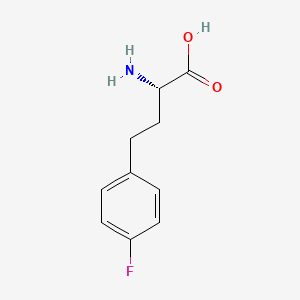
![tert-butyl (5S)-2,4-dioxo-1,3,9-triazaspiro[4.5]decane-9-carboxylate](/img/structure/B8064146.png)

![(7S)-spiro[2.5]octan-7-amine;hydrochloride](/img/structure/B8064163.png)
![(1'R,2R,3S,4'S,6S,8'R,10'Z,12'S,13'S,14'Z,16'Z,20'R,21'R,24'S)-2-cyclohexyl-21',24'-dihydroxy-12'-[(2R,4S,5S,6S)-5-[(2S,4S,5S,6S)-5-hydroxy-4-methoxy-6-methyloxan-2-yl]oxy-4-methoxy-6-methyloxan-2-yl]oxy-3,11',13',22'-tetramethylspiro[2,3-dihydropyran-6,6'-3,7,19-trioxatetracyclo[15.6.1.14,8.020,24]pentacosa-10,14,16,22-tetraene]-2'-one](/img/structure/B8064169.png)
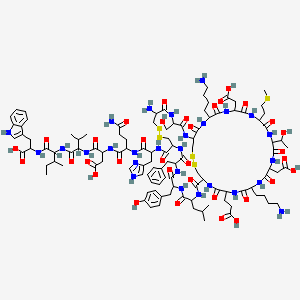
![4-[[2-[[1-[[1-[[1-[[1-[[1-[[1-[[1-[[1-[[1-[[1-[[6-amino-1-[[5-amino-1-[[1-[[1-[[1-[[6-amino-1-[[6-amino-1-[[1-[[1-[[1-[[1-[[1-[[1-[[2-[[6-amino-1-[[1-[[1-[[6-amino-1-[[5-amino-1-[[1-[[1-[[6-amino-1-[[4-amino-1-[(1,6-diamino-1-oxohexan-2-yl)amino]-1,4-dioxobutan-2-yl]amino]-1-oxohexan-2-yl]amino]-3-methyl-1-oxobutan-2-yl]amino]-5-carbamimidamido-1-oxopentan-2-yl]amino]-1,5-dioxopentan-2-yl]amino]-1-oxohexan-2-yl]amino]-3-(4-hydroxyphenyl)-1-oxopropan-2-yl]amino]-5-carbamimidamido-1-oxopentan-2-yl]amino]-1-oxohexan-2-yl]amino]-2-oxoethyl]amino]-4-methyl-1-oxopentan-2-yl]amino]-3-methyl-1-oxobutan-2-yl]amino]-1-oxopropan-2-yl]amino]-1-oxopropan-2-yl]amino]-4-methyl-1-oxopentan-2-yl]amino]-3-(4-hydroxyphenyl)-1-oxopropan-2-yl]amino]-1-oxohexan-2-yl]amino]-1-oxohexan-2-yl]amino]-3-methyl-1-oxobutan-2-yl]amino]-1-oxopropan-2-yl]amino]-4-methylsulfanyl-1-oxobutan-2-yl]amino]-1,5-dioxopentan-2-yl]amino]-1-oxohexan-2-yl]amino]-5-carbamimidamido-1-oxopentan-2-yl]amino]-3-(4-hydroxyphenyl)-1-oxopropan-2-yl]amino]-5-carbamimidamido-1-oxopentan-2-yl]amino]-3-hydroxy-1-oxopropan-2-yl]amino]-3-(4-hydroxyphenyl)-1-oxopropan-2-yl]amino]-3-hydroxy-1-oxopropan-2-yl]amino]-3-carboxy-1-oxopropan-2-yl]amino]-3-hydroxy-1-oxobutan-2-yl]amino]-1-oxo-3-phenylpropan-2-yl]amino]-3-methyl-1-oxopentan-2-yl]amino]-2-oxoethyl]amino]-3-[[2-[[2-amino-3-(1H-imidazol-4-yl)propanoyl]amino]-3-hydroxypropanoyl]amino]-4-oxobutanoic acid](/img/structure/B8064182.png)
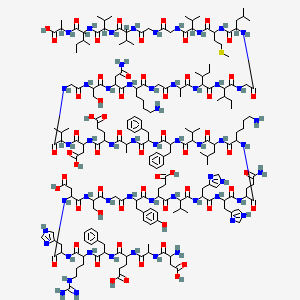
![4-[2-[[2-[[2-[[2-[[5-amino-2-[[2-[[5-amino-2-[[2-[[2-[2-[[2-[[2-[[2-[[2-[[2-[[2-[[2-[[2-[[2-[[2-[[2-[[2-[[2-[[2-[[2-[[2-[[2-[[1-[4-amino-2-[(2-amino-3-carboxypropanoyl)amino]-4-oxobutanoyl]pyrrolidine-2-carbonyl]amino]-3-hydroxypropanoyl]amino]-4-methylpentanoyl]amino]-3-hydroxypropanoyl]amino]-3-methylpentanoyl]amino]-3-carboxypropanoyl]amino]-4-methylpentanoyl]amino]-3-hydroxybutanoyl]amino]-3-phenylpropanoyl]amino]-3-(1H-imidazol-4-yl)propanoyl]amino]-4-methylpentanoyl]amino]-4-methylpentanoyl]amino]-5-carbamimidamidopentanoyl]amino]-3-hydroxybutanoyl]amino]-4-methylpentanoyl]amino]-4-methylpentanoyl]amino]-4-carboxybutanoyl]amino]-4-methylpentanoyl]amino]propanoylamino]-5-carbamimidamidopentanoyl]amino]-3-hydroxybutanoyl]amino]-5-oxopentanoyl]amino]-3-hydroxypropanoyl]amino]-5-oxopentanoyl]amino]-5-carbamimidamidopentanoyl]amino]-4-carboxybutanoyl]amino]-5-carbamimidamidopentanoyl]amino]propanoylamino]-5-[[5-amino-1-[[4-amino-1-[[1-[[1-[[1-[[1-[[1-[[1-[(1-amino-3-methyl-1-oxobutan-2-yl)amino]-3-hydroxy-1-oxopropan-2-yl]amino]-3-carboxy-1-oxopropan-2-yl]amino]-1-oxo-3-phenylpropan-2-yl]amino]-3-methyl-1-oxopentan-2-yl]amino]-3-methyl-1-oxopentan-2-yl]amino]-5-carbamimidamido-1-oxopentan-2-yl]amino]-1,4-dioxobutan-2-yl]amino]-1,5-dioxopentan-2-yl]amino]-5-oxopentanoic acid](/img/structure/B8064199.png)
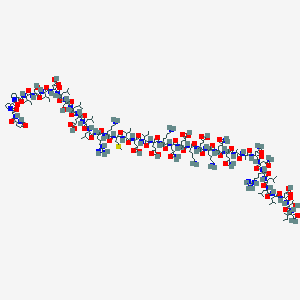
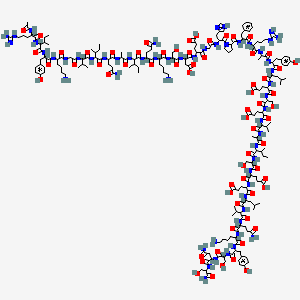
![5-[[6-amino-1-[[5-amino-1-[[5-amino-1-[[1-[[1-[[4-amino-1-[[4-amino-1-[[1-[[1-[[1-[[1-[[1-[[1-[(1-amino-3-methyl-1-oxopentan-2-yl)amino]-3-hydroxy-1-oxobutan-2-yl]amino]-3-carboxy-1-oxopropan-2-yl]amino]-4-methyl-1-oxopentan-2-yl]amino]-4-methyl-1-oxopentan-2-yl]amino]-4-methyl-1-oxopentan-2-yl]amino]-5-carbamimidamido-1-oxopentan-2-yl]amino]-1,4-dioxobutan-2-yl]amino]-1,4-dioxobutan-2-yl]amino]-1-oxopropan-2-yl]amino]-1-oxopropan-2-yl]amino]-1,5-dioxopentan-2-yl]amino]-1,5-dioxopentan-2-yl]amino]-1-oxohexan-2-yl]amino]-4-[[6-amino-2-[[2-[[5-amino-2-[[6-amino-2-[[2-[[2-[[2-[[2-[2-[[6-amino-2-[[2-[[2-[[2-[[2-[(2-amino-3-phenylpropanoyl)amino]-3-(1H-imidazol-4-yl)propanoyl]amino]-4-methylpentanoyl]amino]-4-methylpentanoyl]amino]-5-carbamimidamidopentanoyl]amino]hexanoyl]amino]hexanoylamino]-3-methylpentanoyl]amino]-4-carboxybutanoyl]amino]-3-methylpentanoyl]amino]-4-carboxybutanoyl]amino]hexanoyl]amino]-5-oxopentanoyl]amino]-4-carboxybutanoyl]amino]hexanoyl]amino]-5-oxopentanoic acid](/img/structure/B8064214.png)
